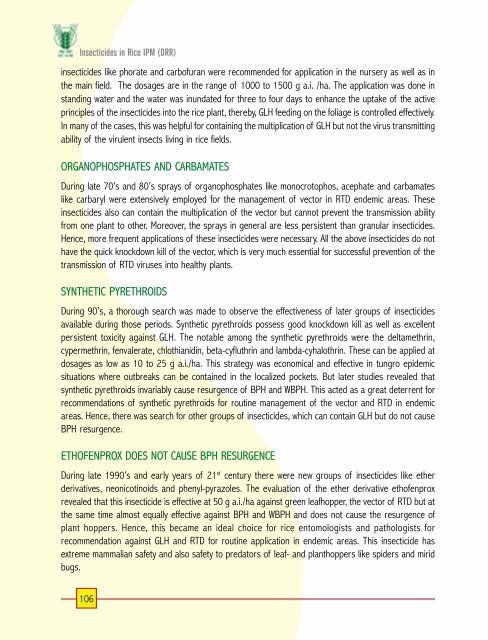priciples of insecticide use in rice ipm
priciples of insecticide use in rice ipm
priciples of insecticide use in rice ipm
Create successful ePaper yourself
Turn your PDF publications into a flip-book with our unique Google optimized e-Paper software.
Insecticides <strong>in</strong> Rice IPM (DRR)<br />
<strong><strong>in</strong>secticide</strong>s like phorate and carb<strong>of</strong>uran were recommended for application <strong>in</strong> the nursery as well as <strong>in</strong><br />
the ma<strong>in</strong> field. The dosages are <strong>in</strong> the range <strong>of</strong> 1000 to 1500 g a.i. /ha. The application was done <strong>in</strong><br />
stand<strong>in</strong>g water and the water was <strong>in</strong>undated for three to four days to enhance the uptake <strong>of</strong> the active<br />
pr<strong>in</strong>ciples <strong>of</strong> the <strong><strong>in</strong>secticide</strong>s <strong>in</strong>to the <strong>rice</strong> plant, thereby, GLH feed<strong>in</strong>g on the foliage is controlled effectively.<br />
In many <strong>of</strong> the cases, this was helpful for conta<strong>in</strong><strong>in</strong>g the multiplication <strong>of</strong> GLH but not the virus transmitt<strong>in</strong>g<br />
ability <strong>of</strong> the virulent <strong>in</strong>sects liv<strong>in</strong>g <strong>in</strong> <strong>rice</strong> fields.<br />
ORGANOPHOSPHATES AND CARBAMATES<br />
Dur<strong>in</strong>g late 70’s and 80’s sprays <strong>of</strong> organophosphates like monocrotophos, acephate and carbamates<br />
like carbaryl were extensively employed for the management <strong>of</strong> vector <strong>in</strong> RTD endemic areas. These<br />
<strong><strong>in</strong>secticide</strong>s also can conta<strong>in</strong> the multiplication <strong>of</strong> the vector but cannot prevent the transmission ability<br />
from one plant to other. Moreover, the sprays <strong>in</strong> general are less persistent than granular <strong><strong>in</strong>secticide</strong>s.<br />
Hence, more frequent applications <strong>of</strong> these <strong><strong>in</strong>secticide</strong>s were necessary. All the above <strong><strong>in</strong>secticide</strong>s do not<br />
have the quick knockdown kill <strong>of</strong> the vector, which is very much essential for successful prevention <strong>of</strong> the<br />
transmission <strong>of</strong> RTD vir<strong>use</strong>s <strong>in</strong>to healthy plants.<br />
SYNTHETIC PYRETHROIDS<br />
Dur<strong>in</strong>g 90’s, a thorough search was made to observe the effectiveness <strong>of</strong> later groups <strong>of</strong> <strong><strong>in</strong>secticide</strong>s<br />
available dur<strong>in</strong>g those periods. Synthetic pyrethroids possess good knockdown kill as well as excellent<br />
persistent toxicity aga<strong>in</strong>st GLH. The notable among the synthetic pyrethroids were the deltamethr<strong>in</strong>,<br />
cypermethr<strong>in</strong>, fenvalerate, chlothianid<strong>in</strong>, beta-cyfluthr<strong>in</strong> and lambda-cyhalothr<strong>in</strong>. These can be applied at<br />
dosages as low as 10 to 25 g a.i./ha. This strategy was economical and effective <strong>in</strong> tungro epidemic<br />
situations where outbreaks can be conta<strong>in</strong>ed <strong>in</strong> the localized pockets. But later studies revealed that<br />
synthetic pyrethroids <strong>in</strong>variably ca<strong>use</strong> resurgence <strong>of</strong> BPH and WBPH. This acted as a great deterrent for<br />
recommendations <strong>of</strong> synthetic pyrethroids for rout<strong>in</strong>e management <strong>of</strong> the vector and RTD <strong>in</strong> endemic<br />
areas. Hence, there was search for other groups <strong>of</strong> <strong><strong>in</strong>secticide</strong>s, which can conta<strong>in</strong> GLH but do not ca<strong>use</strong><br />
BPH resurgence.<br />
ETHOFENPROX DOES NOT CAUSE BPH RESURGENCE<br />
Dur<strong>in</strong>g late 1990’s and early years <strong>of</strong> 21 st century there were new groups <strong>of</strong> <strong><strong>in</strong>secticide</strong>s like ether<br />
derivatives, neonicot<strong>in</strong>oids and phenyl-pyrazoles. The evaluation <strong>of</strong> the ether derivative eth<strong>of</strong>enprox<br />
revealed that this <strong><strong>in</strong>secticide</strong> is effective at 50 g a.i./ha aga<strong>in</strong>st green leafhopper, the vector <strong>of</strong> RTD but at<br />
the same time almost equally effective aga<strong>in</strong>st BPH and WBPH and does not ca<strong>use</strong> the resurgence <strong>of</strong><br />
plant hoppers. Hence, this became an ideal choice for <strong>rice</strong> entomologists and pathologists for<br />
recommendation aga<strong>in</strong>st GLH and RTD for rout<strong>in</strong>e application <strong>in</strong> endemic areas. This <strong><strong>in</strong>secticide</strong> has<br />
extreme mammalian safety and also safety to predators <strong>of</strong> leaf- and planthoppers like spiders and mirid<br />
bugs.<br />
106











